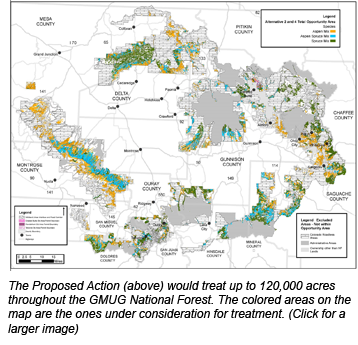Tell the Forest Service to scale back this massive forest treatment proposal
It could be coming to a forest near you: a 10-year-long project to log, burn or otherwise treat 120,000 acres of the Grand Mesa, Uncompaghre and Gunnison (GMUG) National Forest.
The Forest Service says the treatments are needed to address a spruce beetle epidemic and aspen decline. While we agree that these are concerns, we believe the plan as proposed is too big and too open-ended.
If you live next to or play in the GMUG, please make your voice heard on this massive and potentially precedent-setting project!
What is the Spruce Beetle Epidemic and Aspen Decline Management Response?
In late May, the Forest Service released its draft proposal for the Spruce Beetle Epidemic and Aspen Decline Management Response project (fondly known as SBEADMR). The public comment period is set to close on July 31.
The Draft Environmental Impact Statement for the project is proposing to treat up to 120,000 acres over a 10-year period. Each year up to 6,000 acres would be logged for commercial timber, and another 6,000 acres would be treated non-commercially through the use of prescribed fire and other techniques.
A project of this size and scale would have far-reaching impacts on everything from wildlife habitat to soils and watershed quality to new road construction.
After careful consideration, WCC and our allies are calling for the Forest Service to consider a smaller and more focused project designed to protect public safety and prioritize forest health. We’re not opposed to cutting trees, but we believe that the stated goals and objectives of this project can be accomplished through a smaller proposal.
Help us send this message to the Forest Service through our action page now!
WCC’s basic concerns about this proposal are:
- Size and scale. 120,000 acres is a lot of land.
- Public process. Although the Forest Service has laid out a plan for public involvement throughout the life of the project through an “adaptive management” framework, only one Environmental Impact Statement will be done for the whole project.
- Scientific basis. The science behind forest health and tree regeneration in the face of epidemics and climate change is still being developed. SBEADMR needs to incorporate the best and most up-to-date information.
- Priorities. The project should focus on protecting public health and safety first. With its limited dollars, the Forest Service needs to prioritize treating areas that pose a fire and safety threat to Western Slope communities.
Again, the comment deadline is July 31, but I encourage you to submit your comment now. If you’ve only got a second, you can just submit the pre-written letter we’ve supplied on our action page.
If you’ve got a little more time, by all means write your own letter - see our detailed comment guide here. For more information on SBEADMR and a copy of the DEIS itself, visit the Forest Service project website.
If you have any questions, don’t hesitate to contact the WCC office at 970-250-8515.

